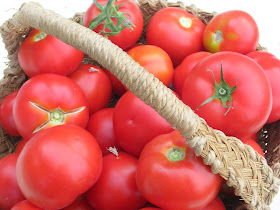 |
| Wild thyme in bloom on a hillside. |
Clumps of flowering thyme on the sun-baked hillside near my house give off a powerful scent. They attract me and the bees. I pick handfuls of the herb to use in the kitchen, to dry for future use. I think thyme is my most favorite herb, so redolent of Mediterranean landscape. I scatter it over simple roast chicken, pork and lamb, add it to soups and stews.
With thyme on my hands, I’m looking for other ways to cook with it. In spite of its availability, thyme is not widely used in the traditional Spanish kitchen. Parsley is absolutely the favorite herb in Spanish cooking. Oregano is widely used, especially in marinades such as adobo. While pots of basil are kept for perfuming the kitchen, the herb is never used in traditional dishes. Although, with TV chefs showing dishes from other countries, more venturesome housewives might experiment with basil.
Rosemary, which also grows wild in the Mediterranean landscape, may be used to fuel a bread oven, but is rarely added to the cook pot. However, in Valencia, a sprig of rosemary is often added to paella when there is no wild rabbit or snails to provide the subtle herbal flavor.
Thyme is an essential flavoring ingredient in home-cured Spanish olives (the recipe is here). And, it almost always goes into dishes with rabbit, whether wild or farmed.
Rabbit with Beans and Pasta
Conejo con Gurullos
This dish is typical of Almería in eastern Andalusia. The simple pasta is made by rolling thin cords of dough, then twisting off short, pea-sized bits. The pasta is cooked right in the broth with the rabbit. If you don’t want to make the pasta, substitute packaged orzo or Israeli cous cous (which is pasta shaped in round balls).
Serves 4.
For the pasta:
 |
| Pasta to cook with rabbit. |
1 cup flour, preferably hard wheat
½ teaspoon salt
1 tablespoon olive oil
5 tablespoons water
a few drops of yellow food coloring (optional)
Combine the flour and salt in a bowl or on a pastry board. Make a well in the center and add the oil, water and food coloring. Mix the flour into the liquid until combined. Turn the dough out onto a lightly floured board and knead the dough until smooth and elastic, about 5 minutes. Cover it and let rest for 1 hour at room temperature.
Take small balls of dough and roll them 1/8-inch thick cords. Twist off ½ -inch pieces (or cut the cords into ½- inch lengths). Spread on a clean cloth to dry until ready to use. The pasta can be thoroughly dried and stored or used fresh.
¼ pound white beans, such as cannellini beans, soaked overnight, or
a large can cooked beans
bay leaf, thyme sprig, slice onion, salt
6 tablespoons olive oil
4 cloves garlic, peeled
2 teaspoons pimentón (paprika)
½ cup white wine
1 rabbit, about 2 ½ pounds, cut into serving pieces
salt and pepper
1 onion, chopped
2 ounces chorizo, skin removed and chopped
2 tomatoes, peeled, seeded and chopped
2 cups water or bean liquid
sprigs of fresh thyme or ½ teaspoon dried thyme leaves
pasta (recipe above) or ½ pound packaged pasta
 |
| Rabbit cooks with beans. |
When the beans are cooked, heat the oil in a cazuela or flameproof casserole and fry the garlic. Remove garlic and crush it in a mortar. Blend in the pimentón, then the wine.
Sprinkle rabbit pieces with salt and pepper. Brown them in the oil. Add the onion and chorizo and fry for 3 minutes. Then add the tomato. Stir in the garlic-wine mixture, water or bean liquid, ½ teaspoon salt and thyme.
Cover and cook 30 minutes. Turn the pieces of rabbit and add the cooked (or canned) beans. Continue cooking until the meat is tender, about 20 minutes longer. Remove the sprigs of thyme.
Uncover the cazuela and turn up the heat so the liquid begins to bubble. Add the pasta and cook until it is tender, about 8 minutes for home-made pasta or 8 to10 minutes for packaged pasta. Allow the cazuela to rest for 5 minutes. Serve in wide soup bowls.
 |
| Thyme-scented rabbit, beans and pasta. |
Notes on the above: Because I was in a hurry, I bought supermarket packaged rabbit. It is hacked up into small pieces, para paella. Awful, because the bone chips are seriously dangerous. Better to buy a whole rabbit and cut it up yourself or know a trusty butcher who will prepare it for you.











